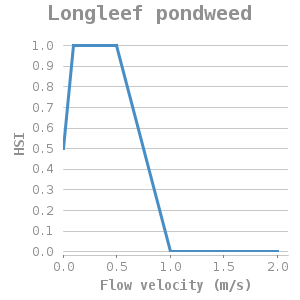H3260 - Water courses of plain to montane levels with the Ranunculion fluitantis and Callitricho-Batrachion vegetation
General
General characteristics |
|
|---|---|
Common name |
Water courses of plain to montane levels with the Ranunculion fluitantis and Callitricho-Batrachion vegetation |
Region |
The Netherlands |
Water system |
water courses |
Nature parameter |
habitats |
HR nr |
H3260 |
Fact sheet by |
H. Coops |
Description habitat
General occurrence
The habitat type Water courses of plain to montane levels includes low land rivers and streams with well-developed submerged or floating water plant vegetation. This habitat includes various water plant communities in flowing water: 1) the association Ranunculo fluitantis - Potametum perfoliati (associations of river water crowfoot and clasping leaf pondweed) Callitrichio hamulatae - Ranunculetum fluitantis (association of Water-starwort and River water crowfoot). Typical characteristics of the first are Longleaf pondweed and Fennel-leaved pondweed. Characteristic for the latter are River water crowfoot species such as Water-starwort, Alpine starwort and Common water-crowfoot.
Characteristic species for this habitat are Longleaf pondweed (Potamogeton nodosus), River water crowfoot (Ranunculus fluitans), Bulrush (Scirpus lacustris), Curly-leaf pondweed, (Potamogeton crispus), Flooting pontweed (Potamogeton natans), arrowhead (Sagittaria sagittifolia), European bur-reed (Sparganium emersum), River water crowfoot (Ranunculus fluitans), Onerow yellowcress (Nasturtium microphyllum), Fennel-leaved Pondweed (Potamogeton pectinatus), Alpine pondweed (Potamogeton alpinus) and Pond water-crowfoot) (Ranunculus peltatus).
Rivers with aquatic plants can be found in shallow zones of faster-flowing channels of the River Rhine branches (Beneden IJssel, Merwedes, Neder-Rijn) and the Meuse River. The Pondweed habitat can be found in permanent channels of large river estuaries, which remain flooded and have a silty soil. Longleaf pondweed also occurs in the downstream area of the Grensmaas and weared parts of the Meuse River. River water crowfoot is occasionally found in the Grensmaas River. Well-developed habitat types are rarely found in The Netherland. Crowfoot and River water crowfoot do not occur at the same location.
Environmental conditions
Rivers with Water-crowfoot are mostly fast flowing, turbulent rivers with a stable substrate of coarse sand or grid on which plants can take root. Water must be sufficiently clear. No stable population occurs in the Grensmaas. Occurrence depends on the presence of propagules supply from tributaries such as the Ourthe, Geul and Jeker. Occurrence is restricted to locations with shallow water during the summer period, without sudden water level fluctuations and with enough current to restrict the growth of algae and sludge. Water starwort does not occur in the Grensmaas as it needs a lower nutrient load.
Longleaf pondweed can be found in The Netherlands near low dynamic rivers with a limited water level fluctuation and low velocities. Its habitat remains inundated and is characterised by a silty, stable soil.
Control and growth opportunities
Good water quality is essential for the development of aquatic plants in rivers. Vegetation will grow poorly if nutrient loads are high. Fennel-leaved pondweed is one of the first species to colonise if conditions improve, and it often can be abundant. For this habitat, the absence of disturbances, such as shipping waves and sudden changes in water level or flow velocity are important
Measures to enhance the growth of water plants in rivers are:
- gravel bars (shallow riffles)
- secondary channels and natural fish traps
- flood control dam management aimed at natural discharge regime
- nature friendly banks with development of shallows in foreshore.
- reducing shore disturbances
Dose-effect relations
Flow chart
Dose-effect relations

flow velocity (m/s) |
HSI |
|---|---|
0 |
0 |
0.1 |
0 |
0.6 |
1 |
1.5 |
1 |
2 |
0 |

flow velocity (m/s) |
HSI |
|---|---|
0 |
0.5 |
0.1 |
1 |
0.5 |
1 |
1 |
0 |
2 |
0 |
Reference: #1
Uncertainty and validation
These dose-effect relations have not been validated.
Applicability
These dose-effect relations apply to brooks and rivers with aquatic plants.
Example project
At present, there is no example of a project available.
References
1 Duel, H. & B. Specken 1994 Standplaatsmodel Rivierfonteinkruid een model voor het analyseren van de standplaatskwaliteit van rivieren voor vegetaties met rivierfonteinkruid (Potamogeton nodosus). INRO-TNO, Delft.